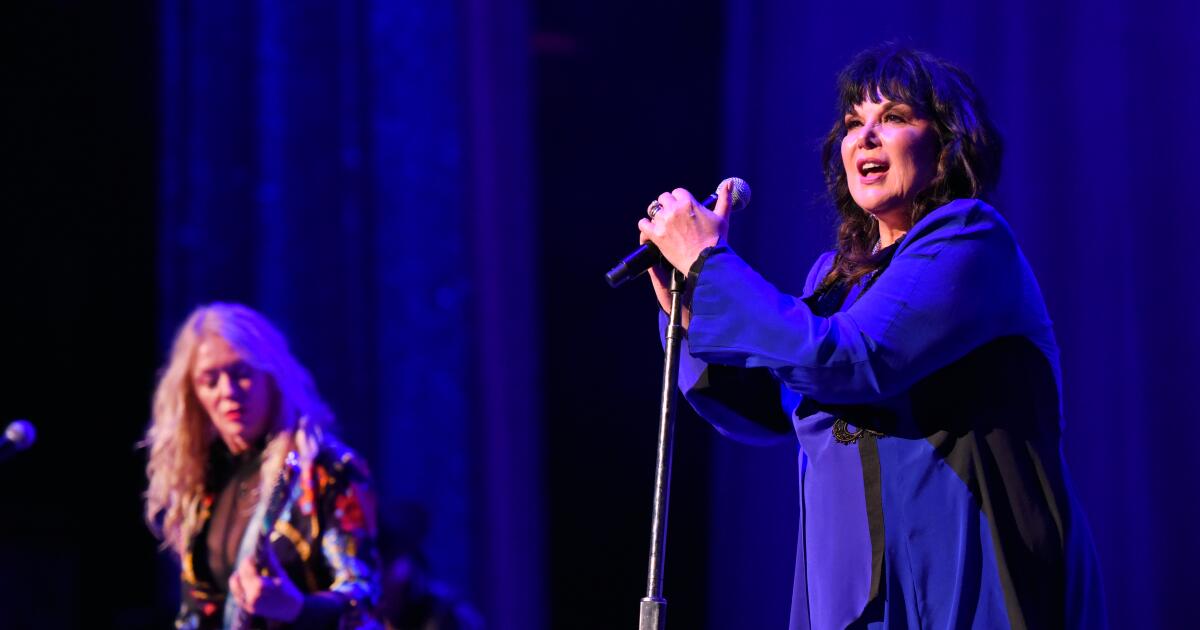On a Baltimore stage in May, Ann Wilson welcomed her audience. “We are Heart,” she said, introducing the chart-topping band. “We are Heart,” her sister Nancy echoed, a little quieter, nodding into the microphone. Each woman’s body language responded to the other. “Still Heart!” Ann said in response to the cheers. “Yup,” Nancy nodded. “Still Heart.”
The introduction mattered. For a while it seemed the sisters might not share the stage again. A rift had opened between them in 2016, when Ann’s then-new husband physically assaulted Nancy’s son. Heart did not tour for years. This year they were finally back, and while a cancer scare for Ann paused the tour, the tour resumes next year.
Heart’s endurance means something different than that of other rock stars still claiming the spotlight in their 70s. Ann and Nancy Wilson exemplify the complex power of sisterhood.
When sisters collaborate toward revolution or success, their joined force comes with mutual caregiving and gratitude — to each other, yes, but also circumstance. Even sisters who share a close bond have usually passed through periods of attenuation. This focus on shared credit subverts the typical American lionization of individual success.
At the Democratic National Convention in August, Maya Harris talked about her sister, Kamala. Their mother, Maya said, “raised us to believe that we could be, and do, anything. And we believed her.” The sisters were close growing up, and Maya chaired her sister’s 2020 campaign for president. These days they joke that Maya will call Kamala “big sister general” until she earns the title of madam president.
Looking at the past, we see many sisters who have helped change history. Amelia Earhart bought her first plane with money she pooled with her beloved sister, Muriel, and their mother. Elizabeth and Emily Blackwell were America’s first and third female doctors. Sarah and Angelina Grimke became famous in part for joining the abolitionist movement, unlike most of their white peers. Suffragists Clara, Elsie and Helena Hill, daughters of a congressman, embraced various forms of radicalism to fight for women’s right to vote.
Venus and Serena Williams weren’t the first Black sisters to be tennis sensations. Before their myriad wins and push for equal pay in the sport, Margaret and Roumania Peters dominated Black women’s tennis in the 1930s and later pressured the U.S. National Championships to desegregate.
And the power of sisterhood hangs like a veil over histories of resistance and change. Patria, Minerva and Antonia Mirabal, for example, helped overthrow dictator Rafael Trujillo in the Dominican Republic in the late 1950s.
In the arts, writers who challenged the feminine status quo often did so with sisters around them. The Brontës, of course, but also Laura Ingalls Wilder, Louisa May Alcott, Jane Austen, Rebecca West and Virginia Woolf, all of whom achieved their successes with competition and support from their sisters. Austen’s mother once said of her daughters that “if Cassandra were going to have her head cut off, Jane would insist on sharing her fate.”
As Ann and Nancy Wilson’s breach shows, sisterhood involves a nuanced loyalty. Through the years of distance, in separate interviews, the sisters talked about how much they loved each other and expressed impatience with a media machine eager to report on their strife. Of a purported “feud,” Ann firmly told the magazine “Classic Rock”: “It’s a myth.” For a woman, a sister can be both your home and the fire that burns your home to embers.
Sisters puncture the purity and singularity that American culture likes to see in its heroes. Recent histories of the Blackwells and the Grimkes have expanded our understanding of how progress is rarely spurred by a single, unsullied person; it takes a multiplicity.
Still, minimization and sensationalism are more common. A recent article about the Mirabal sisters noted that they “may not have seemed the most likely revolutionaries,” but clearly, if one pays attention, the opposite is true. They, the Wilsons, the Harrises and powerful sisters everywhere should be seen as the most natural possible radicals and reformers. Their stories shouldn’t be overlooked or flattened but vaunted and appreciated for just how revolutionary they are.
Julia Cooke is a contributing editor at the Virginia Quarterly Review and the author of several books, including “Come Fly the World: The Jet-Age Story of the Women of Pan Am.”

